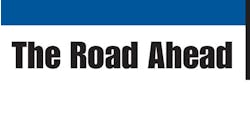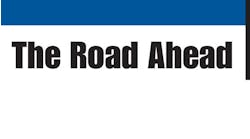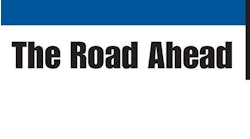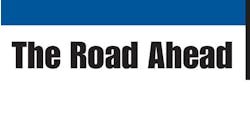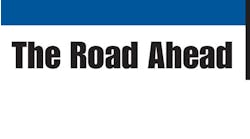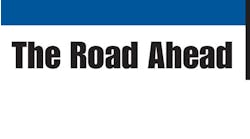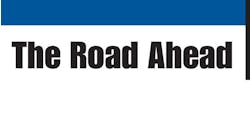As the old joke goes, a man jumped off a 10-story building to prove he could fly. On the way down, with each passing floor, he was heard to say, “So far, so good.”
Martin Regalia, vice president and chief economist for the US Chamber of Commerce, offered this joke while delivering a somewhat hopeful analysis amid what he called a “dour” economic picture.
“While I am optimistic, I'm only at about the fifth floor,” he said. “I will say, ‘So far, so good.’ ”
Regalia sounded a rather sinister bell when he said that our nation doesn't have the infrastructure to support an economy that could grow from $14 trillion this year to $20 trillion in 2018. He said he could see the problems “coalescing into a Perfect Storm” that would plunge America into an economic downturn “that would rival the last real one in the early 1980s.”
But in the short term, he is much more optimistic.
“Near term, I see us getting through,” he said. “Call me a Pollyanna, if you will, but I think we're going to see growth of between 0.5% and 1% in the first quarter and gradual improvement up to about 2.5% by the end of the year.
“That's the forecast, and I'm going to stick to it, drowned if I will.”
He said that over the last 100 quarters, we had only five in which GDP growth was negative. He said he wishes we had a 95% chance of avoiding a recession, but he says it's more like 55%.
“That doesn't mean we throw in the towel,” he said. “But when I look at it realistically, I see an economy that is not hitting on all cylinders, that has significant weak spots, that has few areas of strength — and if they hold true, we're going to get through. But when an economy is that weak and there are sectors that are in outright depression, such as the housing sector … Any of you that are attached to that sector are not going to find solace in the fact that I say we avoided a technical recession, that we squeaked through with 1% GDP growth. I still think there is light at the end of the tunnel that isn't attached to an oncoming train, but I think it's going to be very, very tough through the interim period.”
Consumption drives the beast
He said two-thirds of the economy is consumption. It is what drives everything else. He said in the last recession, America didn't have any negative quarters of GDP growth — largely because of tax cuts passed in 2001 and 2003.
“I'm hoping we'll have an economic-stimulus package again,” he said. “I think it will help continue to keep consumption growing. And if we do, we have a better chance of making it through without a recession.
“Consumption is driven by income. Every additional dollar of income contributes 65 cents into spending. So the deal is continuing income growth. It has remained robust. Even though job growth has been slow, we're still seeing income growth.
“Despite all the problems in the housing market, we're still seeing positive wealth growth. Can we keep growing and will wealth declines be modest enough that they won't overwhelm the income effect? I think we'll have modest consumption over the first half of the year and gradually improve as the year progresses.”
He said business investment will continue to pick up, but it will be modest and will not provide the impetus we normally see at this point of the economic cycle.
“Commercial construction is running good because it's a good time to build, but I don't think that's going to continue,” he said. “My guess is we'll see a very soft commercial construction market. Businesses are a little hesitant to start a new plant when they're not sure that the demand is going to be there. The inventory sales ratio is back down. Businesses are not going to stock up inventories until they see customers in stores, and so they're running lean inventory, and so this isn't going to give much impetus to growth. The best we can hope for from investment is a neutral stance in the first half of the year.
“We're still seeing industrial demand. Profits are still relatively good, but the problem is that a business with a profitable cash flow looks out there and says, ‘Do I invest in growth in this kind of market or take advantage of the fact that my stock price is depressed, buy it back, and solidify my ownership and control?’ Many businesses are opting for the latter, and that's not helping the economic situation. It's good for business, but not one that helps GDP growth.”
Analysis of other issues
-
Transportation: “We have not seen anything in this data that smacks of the last recession. We're kind of seeing the numbers plateau, but nothing that is a definitive trend. This is indicative of an economy that is hard to gauge. Shipping is down and people are buying less, but it hasn't fallen off the cliff yet. This indicates to me that we're going to see a very slow growth period rather than an outright recession.”
-
Trade sector: “The dollar is weak, growth abroad is good. We build good products and everybody around the world wants them. Exports are offsetting the decline in housing. I think this is likely to continue. In the longer period, I see continued dollar weakness, largely because we borrowed too much money from abroad. When we borrow from abroad and don't save enough domestically and have to get foreign investors to finance investment, it creates capital inflow, and that has to be balanced by net-goods outflow. So what we end up with is a net trade deficit.”
-
Job growth: “There are some reasonably good signs. The fourth quarter saw higher average job growth (94,000) than the third quarter. My guess is we'll see a modest upward revision of the December numbers, and January numbers will show modest job gains (50,000-60,000).”
-
Inflation: “It's highly affected by oil prices. There's not a whole lot to be gleaned from looking at a number that moves around that much. Instead, we like to look at core rates of inflation. This is a number that moves less, and you can get more of a read out of it. It's also a number that is affected by the fundamental supply and demand and tightness of labor markets. The Fed looks at core rates of inflation, and that's what they decide monetary policy on. When the core rates elevate, the Fed does not like to cut rates. Core rates in the 2% to 2.5% range are considered normal. As you go above 2.5%, the Fed gets incredibly skittish about cutting interest rates. We're at 2.9% the last few months and 2.6% over the last six months. Those rates are marginally above the Fed's comfort level. That gives the markets a real pause because they look at the economy and say the economy is weak. And they see those inflation numbers. They know those 300 economists that work at the Fed have all been weaned on fixing inflation. There is a pecking order at the Fed, and inflation is at the top. When I see core rates up at 2.9%, I get a bit worried that the Fed is going to be hogtied and not going to be able to cut rates as much as they want.”
-
Commodity prices: “We're seeing energy and oil prices rise dramatically, and I think they're going to stay up there because of all the industrialization going on in China and around the world. They are soaking up all the raw materials. That's how they're growing their economy. It's not a good long-run strategy, but it's a very effective short-run strategy. So I don't see oil and gas coming down — maybe into the 70s.”
